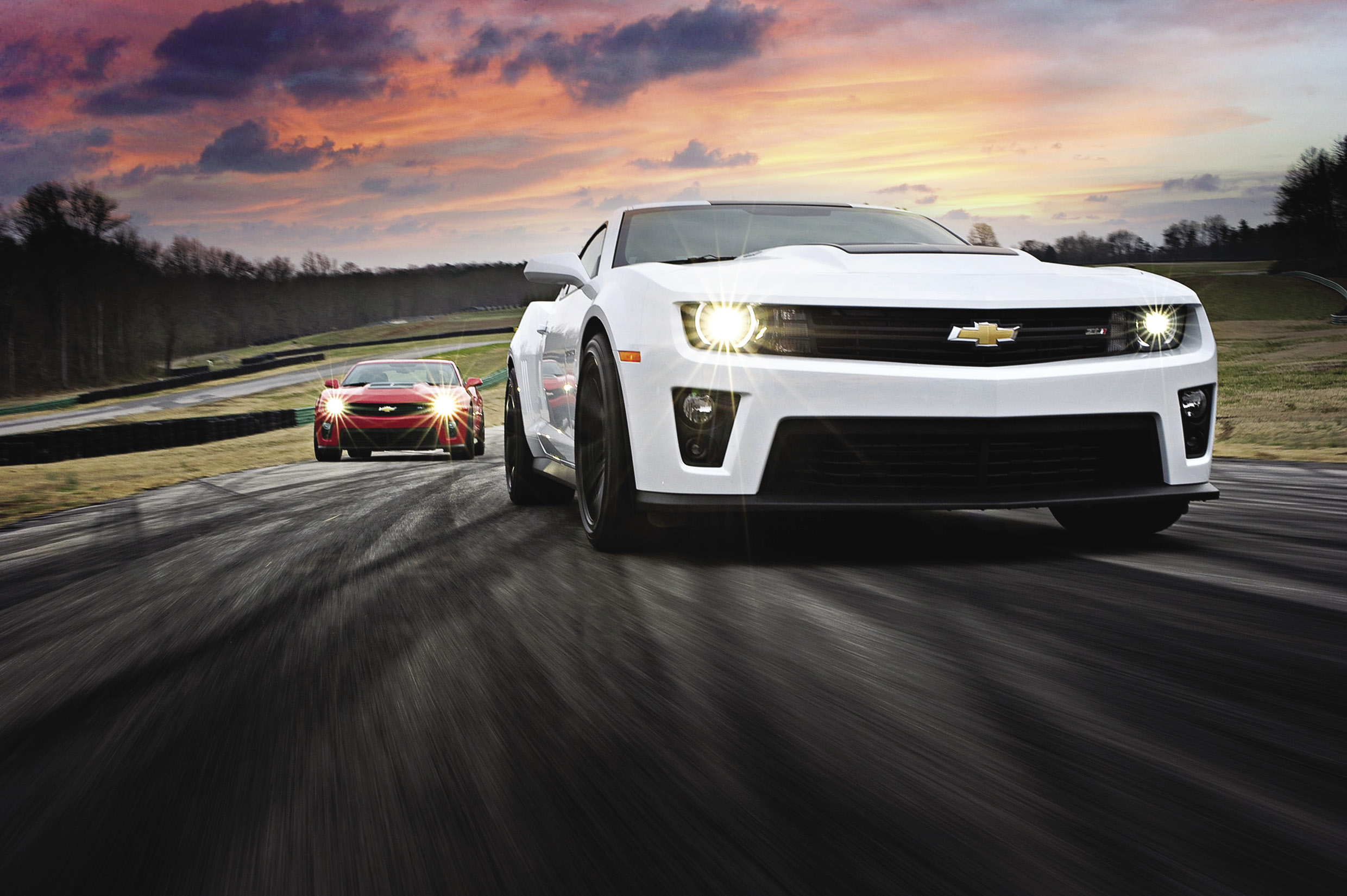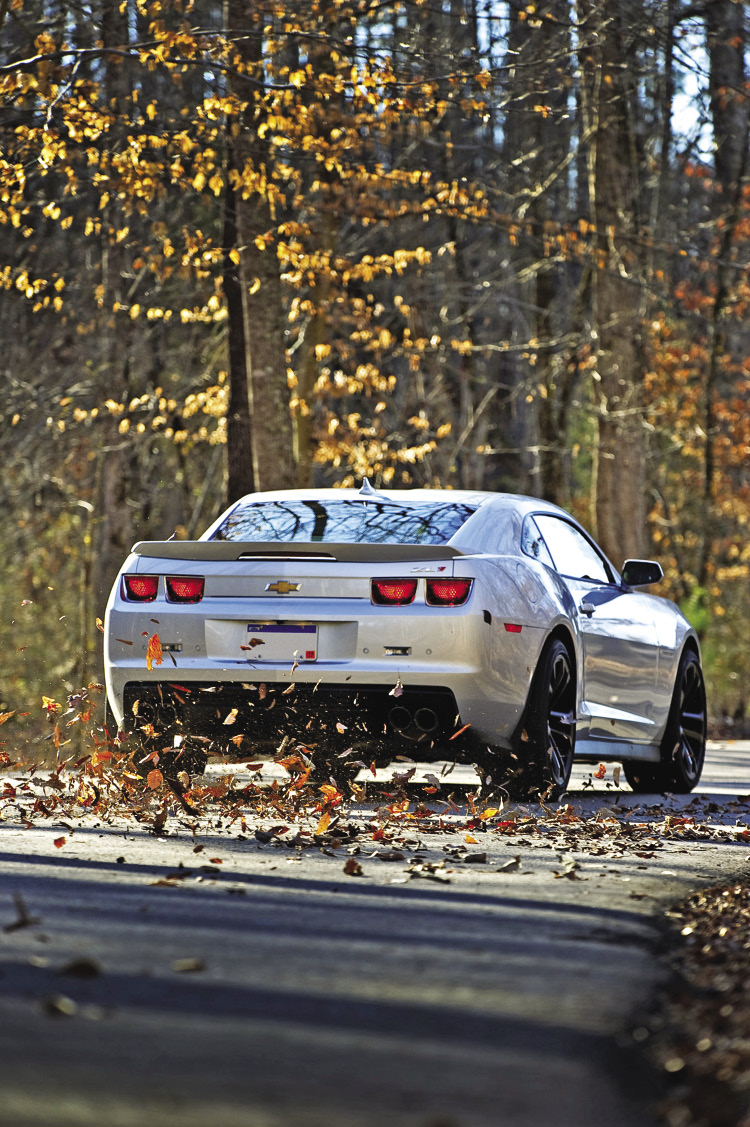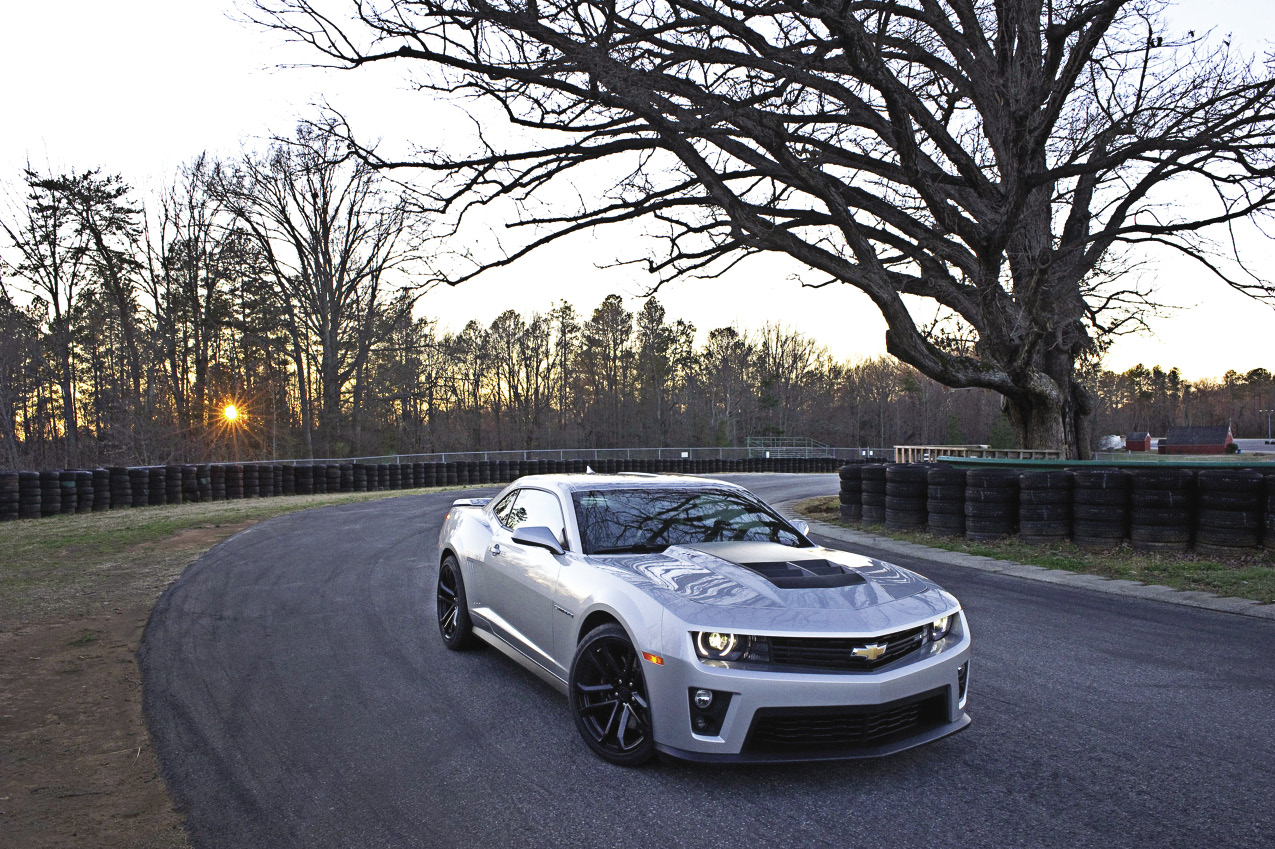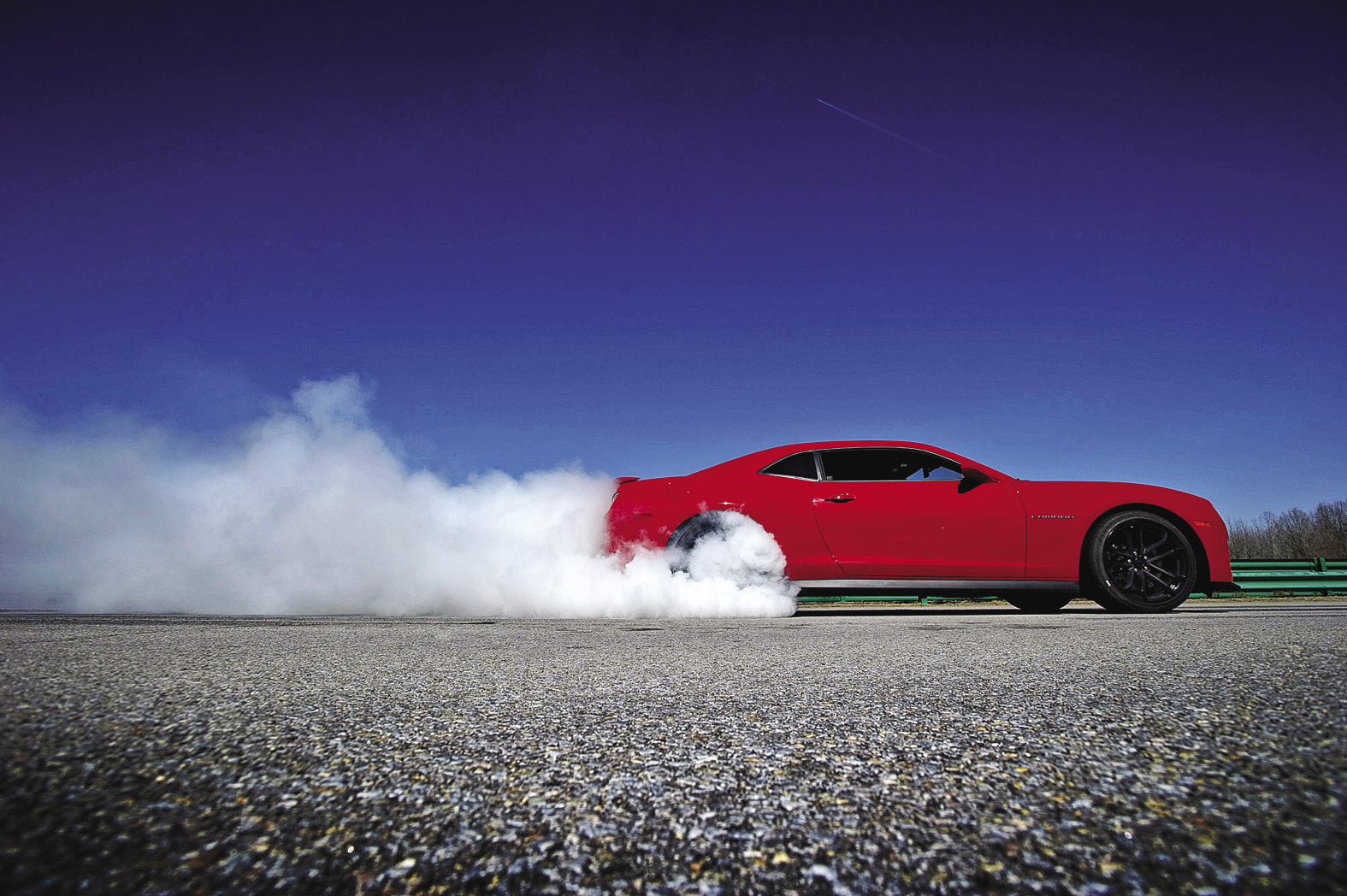
Chevy Takes Its Classic Muscle Car to the Gym
Alton, VA – Nestled in the rolling hills of southern Virginia, hard up against the state line it shares with neighbouring North Carolina is Virginia International Raceway, a 17-turn, 3.27 mile natural terrain road course located in the tiny hamlet of Alton on the banks of the Dan River. It’s so close to the state line that the road leading in actually crosses back and forth between the two jurisdictions.
VIR, as it is known, is a country club of a track, complete with impeccably manicured grounds that are dotted with tidy, barn-like buildings. Lodges overlooking the racing surface – where we were put up for one night – provide the weekend race attendee with very comfortable accommodations, and if he or she would like to set up camp at the track on a more permanent basis, condos are available for purchase.
The purpose of our visit to this scenic circuit was to sample the Oshawa, Ontario-built 2012 Chevrolet Camaro ZL1, the new top of the line, all-out performance model from Chevy’s iconic muscle car nameplate.
Considering the arena in which the ZL1 is going to do battle – Ford’s 650 HP 2013 Shelby GT 500 and the recently unveiled 2013 Dodge Viper that promises something north of 600 ponies, will serve as its primary competition – GM had to crank the aggression factor up to 11 just to remain relevant.
Hence the ZL1 comes equipped loaded for bear some impressive performance credentials, beginning with GM’s 6.2 litre LSA Supercharged V8 engine (the same mill that powers the Cadillac CTS-V), which boasts 580 HP and 566 lbs-ft. of torque.
The LSA engine features a Roots-style blower with a four-lobe rotor set and compact intercooler. The ZL1 also features a standard dual-mode exhaust system, with vacuum-actuated valves in the exhaust pipes for an appropriate deep-bass rumble at low speeds as well as a free-flowing system for peak performance.
Power is delivered to the rear wheels through either a six-speed manual or automatic transmission. With either transmission, the ZL1 puts down some pretty impressive performance numbers (all figures courtesy of GM):
| Manual | Automatic | |
| 0-96km/h (from rolling start) | 4.0 seconds | 3.9 seconds |
| 1/4-mile (from a rolling start) | 12.1 sec at 191 km/h | 12.0 sec at 191 km/h |
| Top speed | 290 km/h | 297 km/h |
| Max lateral grip | 1.0 g | 1.0 g |
Camaro chief engineer Al Oppenheiser, on hand at VIR, summed up the ZL1’s performance credentials thusly: “With 0 to 96 km/h taking less than four seconds, and a top speed in excess of 297 km/h, the power and acceleration of the Camaro ZL1 rivals many supercars. And, horsepower is only half of the story, as the most significant measurement of the ZL1’s potential is lapping the Nurburgring in 7:41.27. That is a great testament to the power, braking, grip, and balance of the Camaro ZL1, and to the well-rounded performance of the ZL1 that sets the bar for the sports-car segment.”
7:41.27. That is a great testament to the power, braking, grip, and balance of the Camaro ZL1, and to the well-rounded performance of the ZL1 that sets the bar for the sports-car segment.”
Putting all of this power to the ground are a pair of 6-speed transmissions, a Tremec TR6060 twin-disc manual and a Hydra-Matic 6L90 automatic equipped with a manual mode. The rolling gear is also pretty impressive thanks to 20-inch forged alloys that come wrapped in Goodyear Eagle F1 rubber. Stopping power is delivered thanks to massive two-piece Brembo rotors measuring 14.6 inches up front and 14.4 in the rear, with six and four piston calipers.
To keep all of this power adhered to the road GM has equipped the ZL1 with some sophisticated suspension technology. Now in its third iteration, GM’s Magnetic Ride employs valve-less damping and Magento-Rheological fluid technology to adjust suspension firmness to match changing road and driving conditions.
“Traditional suspension systems at some point compromise ride quality for road-holding grip and body control,” Oppenheiser said. “With Magnetic Ride Control, we can offer customers the best of both worlds: A comfortable ride that makes the ZL1 appropriate as a daily driver and the incredibly precise body control that makes the ZL1 so enjoyable on the track.”

Integrating all of this technology together – along with traction control, launch control, electronic stability control and electric power steering – is the ZL1’s standard Performance Traction Management system, first employed by the Corvette ZR1.
With launch control, for example (available only with the manual transmission), the system modulates engine torque to minimize wheel spin. The system keeps the engine at a predetermined speed until the driver releases the clutch, and then it modulates engine torque 1,000 times per second in order to maximize available traction.
The system has five driver-adjustable settings which govern Performance Traction, Active Handling, Suspension Mode and Steering. As the driver cycles up through the settings, system intervention is gradually curtailed up to Mode 5, when everything is shut off. At this point, the car is in basically ready to race- probably not the ideal setting for public roads.
On the aesthetic side of things, GM’s designers have spent plenty of time making sure the ZL1 looks the part, too. The car looks fast and track-ready, thanks to its flared front and rear fenders, vented carbon-fibre hood, front splitter, rear spoiler and quad outlet exhausts.
 While it might look like a garden variety SS model from a distance, these styling details –along with options like black forged alloy wheels and a vented carbon-fibre hood – and some tasteful ZL1 badging serve as fair warning that this is no ordinary Camaro.
While it might look like a garden variety SS model from a distance, these styling details –along with options like black forged alloy wheels and a vented carbon-fibre hood – and some tasteful ZL1 badging serve as fair warning that this is no ordinary Camaro.
Some of these touches merely enhance the ZL1’s appearance, while others such as the vented carbon-fibre hood, front splitter and rear spoiler exist to improve the car’s stability at high speeds through the production of downforce – the physics principle that helps to keep a vehicle planted to the road. According to GM, the ZL1 generates 65 pounds of downforce, compared to 200 pounds of lift in the Camaro SS.
The ZL1’s muscle car character continues on the inside where GM has put forth a good effort to update and refine the cabin, while not extinguishing the rough around the edges feel that American muscle cars have had for decades.
Make no mistake, the ZL1 is a thoroughly modern car, and comes equipped with an array of amenities one would expect, including satellite radio, Bluetooth integration, a host of power controls (many of which are mounted on the steering wheel), a performance gauge cluster on the centre stack, and GM’s ubiquitous OnStar navigation system. The ZL1 also comes with a very futuristic-looking head-up display (HUD) which provides the driver with various data, such as speed and – get this – G-sensor readings.
Impressions
Because the ZL1 is a hulking muscle car, one accepts certain tradeoffs the minute he or she grabs the door handle – the fun does come at a bit of a price, after all.
For example, the seating position is bunker-like, low-slung with high doors and small windows. Rearward visibility is limited, with large blind spots, typical for cars of this ilk. A fellow scribe said it was like, “riding in a bathtub,” albeit a really fast and powerful bathtub.
The interior trim materials are better than what one would find in lesser Camaros, and the amount of gadgetry has been suitably increased – although we’re not sure how many buyers will actually use the pod of performance gauges in the centre stack for anything other than visual entertainment – but the ZL1 isn’t a Porsche or a BMW, so buyers shouldn’t be expecting anything too luxurious.
The dash and instrument panel still features plenty of hard plastic, and the chunky climate control knobs looked a little low rent. We hasten to add that they worked fine, but didn’t exactly exude a look of precision.
We were quite impressed with the seats and the overall driving position, however, (rearward visibility issues notwithstanding) and the optional suede package (seat and dash inserts, shift knob and steering wheel) felt like it was of a high quality and added to the performance feel. The wheel wasn’t too big or small and we liked the sporty feel of the stitched shift knob.
Late February might be cold and miserable where we come from, but in southern Virginia, the temperatures are much more hospitable. The mercury was reaching the upper teens during the two days we were on site, and there was no evidence of snow to be found anywhere. Milder winters certainly made for better driving conditions on area roads, which were almost completely free of cracks, bumps and broken asphalt, unlike the weatherbeaten roads in and around Toronto. For country roads far off the beaten path, they were remarkably smooth. The ZL1 proved to be quite hospitable on these roads, and the pleasant sounding growl of the exhaust made for plenty of fun driving.
But the real fun was at the track, where the ZL1 really shines. We spent the better part of a day wringing out both manual and automatic versions of the car on the undulating VIR tarmac, and came away mightily impressed with the car’s performance bonafides.
It took a few laps to get used to the immense power the ZL1 puts down at launch – the launch control was definitely helpful in that regard – and the gobs of torque that wanted to snap the rear end out in just about every turn. Once we had a feel for the ZL1 – and the somewhat tricky VIR track – flinging it around the 17- turn circuit was a lot of fun.
We kept the Performance Traction settings in the mid-range (Modes 2-3) at the behest of GM, which still enabled us to get a feel for the ZL1’s handling characteristics, while taking advantage of the LSA’s immense power delivery. While some scribes undoubtedly turned everything off, we weren’t tempted to do so after seeing photos of a car that went off track on the first day, crumpling the front end of a sharp looking lava orange tester in the process. We’re not keen on footing massive repair bills.
 It goes without saying that with most performance cars, you need a manual transmission to wring the most out of it, and we found this to be true with the ZL1 as well. The 6-speed manual Tremec gearbox worked flawlessly, and seemed well-suited to maximize the beastly LSA engine. The clutch pedal feel was quite good and the short throw shifter made gear selection a breeze.
It goes without saying that with most performance cars, you need a manual transmission to wring the most out of it, and we found this to be true with the ZL1 as well. The 6-speed manual Tremec gearbox worked flawlessly, and seemed well-suited to maximize the beastly LSA engine. The clutch pedal feel was quite good and the short throw shifter made gear selection a breeze.
The Hydra-Matic transmission worked fine also, but made the car feel a bit more lethargic and numb – we couldn’t get the power down in the same manner and weren’t always happy with the shift pattern the ECU employed on track. We concede that this is unlikely to be much of an issue in day-to-day commuting on the highway or cruising on city streets where the car won’t be driven nearly as hard.
One aspect of the ZL1 that owners will appreciate whether they’re on track or lurching through rush hour traffic is the immense stopping power of the Brembo brakes. We overshot our braking zone a few times – dropped a couple of wheels off the track, too – and the brakes saved us every time. They’re more than adequate to handle any normal day-to-day driving condition an owner might find him or herself in.
During the multimedia presentation GM made to the assembled media at the track on the night we arrived, an executive put up a slide comparing the ZL1’s price and performance numbers with those of some other well-known European sports cars. None of the other three cars were priced within $50,000 (US) of the ZL1, nor did they produce as much horsepower or torque. Two of the three don’t offer Magnetic Ride as an option either.
Perhaps more than anything else, this is what GM can really use to entice prospective buyers into Chevrolet showrooms to give the ZL1 a long, serious look: value for money.
The ZL1 starts at $58,000, and save for a handful of mostly appearance-related options (suede package, striping kit, sunroof, etc.), comes completely loaded from the factory. The only serious mechanical option is the automatic transmission, which many buyers are likely to forego.
A locked and loaded, track-ready car packing 580 horsepower for less than $60,000?
Sign us up.

Specifications
Price: $58,000 (base)
Engine: 6.2L LSA Supercharged and Intercooled V8
Output: 580 hp @ 6,100 rpm; 566 lbs.-ft torque @ 3,800 rpm
Platform: FR
Fuel Consumption (manufacturer): N/A (at press time)























